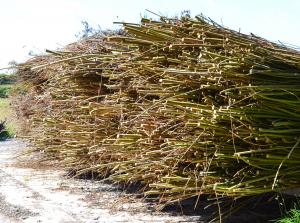In Northern Ireland, the Department of Enterprise, Trade and Investment (DETI) have set a number of important renewable energy targets, including 10% heat from renewable sources by 2020. As a driver, The Renewable Heat Incentive (RHI) provides payments to help with the economics of domestic and non-domestic installations of biomass boilers.

Energy from woody biomass is ideal for heat production with Short Rotation Coppice (SRC) willow being the main renewable energy biomass crop grown in N.Ireland. The Agri-Food and Biosciences Institute (AFBI) has been involved in the growing and utilisation of energy crops including SRC willow for many years. Recent research into the use of paper-based laminate covers to protect stacked harvested willow stems has demonstrated how this simple and convenient method can maximise the amount of energy obtained by reducing moisture content (MC) and conversely increasing the calorific and financial value of the biomass crop.
Growing SRC willow
Willow is planted from stem cuttings and is cut back after the first year of growth to allow extra stems to sprout. The first harvest usually takes place either two or three years after this cutback and thereafter commonly on three-year cycles. Harvesting is generally carried out in the winter months when leaves are absent and site conditions allow harvesting machinery access. The rootstock remains in the ground with new shoots re-emerging the following spring. Estimates are that the plantations will have a lifespan of approximately 25 years.
Direct Chip Harvest
There are currently two main harvesting methods used in Northern Ireland, direct chip harvesting and whole stem harvesting. With the direct chip harvesting option, the crop is cut and chipped in a single pass and the resulting material blown into trailers for removal. The moisture content (MC) of fresh wood at harvest is in excess of 50%, so it must immediately either be used in suitable applications or artificially dried following harvest to prevent deterioration due to self-heating, self-degradation and loss of calorific value. This can also lead to potential health and safety implications with fungal spore production and mould growth. Dedicated drying facilities are therefore required to reduce the moisture content to below 25% where biomass storage is stable and use efficiency will be high. These drying facilities are expensive and require significant energy inputs.
Whole stem harvest
Whole stem harvesters cut the crop as entire rods which must be collected and removed to storage areas. The stems require handling a second time and are ultimately chipped prior to use. Where possible the stems are stacked, preferably on a hard surface and ideally raised off the ground to allow optimum ventilation and natural dying. Willow harvested as whole stems do not have the same self-heating potential and can be left to dry naturally over the summer period before being chipped. Previous AFBI research has shown that stacked willow stems can dry naturally over the summer months to approximately 25% MC, however during the following winter months a certain amount of re-wetting takes place with MC rising to approximately 30%.
AFBI has conducted trials into the use of a waterproof paper- based laminate cover consisting largely of natural fibre. A very thin plastic layer within the cover makes it both waterproof and strong. However due to the characteristics of the fibre cover, it can be chipped along with the residue and combusted in the boiler. The cover shelters the top of the pile leaving the sides open allowing moisture to evaporate. Stacks of two and three-year-old willow stems were sampled on a two- weekly basis during summer 2014, the following winter and continuing through 2015. Willows underneath the cover became drier than those left uncovered with the moisture content of both two and three-year-old stems remaining below 25% with no re-wetting occurring during the winter months.
In conclusion
Cutting, storage and covering of whole stems offers an alternative drying approach which may be more appropriate to growers with smaller areas of SRC willow who do not have access to a drying floor. Chip with MC below 25% is stable and will provide a continuity of supply to the end user. The development of low-cost drying systems for willow is one aspect of the development of sustainable quality wood chip supply chains. Use of this type of paper laminate cover appears to provide a viable beneficial alternative method to assist the natural drying of willow stems producing a good quality wood chip.
AFBI Wood Chip Quality Workshop
The quality of wood chip is extremely important in order to maintain a well-running biomass heat system. Aspects such as chip sizing, moisture content and ash content all have their parts to play. AFBI will be exploring these aspects and how we can improve wood chip quality in Northern Ireland at a workshop to be held in association with CAFRE, BENI and WFQA at Large Park, AFBI Hillsborough at 1.30pm on 8th September. To register to attend, please call Anne Fisher on 028 3889 2325.
Notes to editors:
AFBI carries out high-quality technology research and development, statutory, analytical, and diagnostic testing functions for DARD and other Government departments, public bodies and commercial companies.
AFBI's Vision is “Scientific excellence in Northern Ireland … serving the world”
All media enquiries to AFBI Press Office
Latest news
- AFBI issues Nematodirus warning – Spring 2025 11 April 2025
- Managing Nature Based Risks to the UK Economy and Opportunities for Green Finance 08 April 2025
- AFBI Hillsborough host AERA committee 27 March 2025
- The Omics Days Conference 27 March 2025
